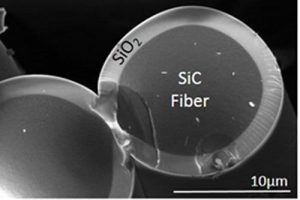 Ceramic Matrix Composites (CMCs) components are being introduced in aircraft turbine engines to replace some superalloy components. Use of CMCs for these applications results in turbine efficiency gains due to their ability to withstand higher temperatures, reduced need for cooling air, and lower density than the superalloy components. CMCs designed for aircraft engine applications consist of SiC fibers, a BN interphase, and a SiC matrix. The SiC fibers toughen the normally-brittle ceramic material. It is critical, therefore, to understand the thermochemical behavior of the SiC fibers affecting CMC lifetimes in the extreme environmental conditions present in an aircraft turbine engine.
Ceramic Matrix Composites (CMCs) components are being introduced in aircraft turbine engines to replace some superalloy components. Use of CMCs for these applications results in turbine efficiency gains due to their ability to withstand higher temperatures, reduced need for cooling air, and lower density than the superalloy components. CMCs designed for aircraft engine applications consist of SiC fibers, a BN interphase, and a SiC matrix. The SiC fibers toughen the normally-brittle ceramic material. It is critical, therefore, to understand the thermochemical behavior of the SiC fibers affecting CMC lifetimes in the extreme environmental conditions present in an aircraft turbine engine.
The first stage turbine in an aircraft engine will operate at combustion gas temperatures greater than 1200 °C. The ability of the SiC fibers within CMCs to resist thermal oxidation at this temperature is critical to the strength and lifetime of the component. Many oxidation studies of both SiC fibers and Chemically Vapor Deposited (CVD) SiC have been reported in the literature. Bulk CVD-SiC oxidation studies have been reviewed, but an equivalent review on SiC fiber oxidation studies did not previously exist.
The present study, by Wilson and Opila, from the University of Virginia, is the first to review the available SiC fiber oxidation data and compare oxidation rate constants, activation energies, and experimental procedures. New experimental results for Hi-Nicalon SiC fiber oxidation in dry O2 in a well-controlled environment are also reported. Oxidation rate data were determined from SiO2 thicknesses on the fibers measured using Scanning Electron Microscopy (SEM) and compared to the data available in the literature. Lastly, the authors examine the effect of SiC fiber composition on the oxidation behavior, finding that the amount of SiO2 formed during fiber oxidation increases with increased purity and approach to stoichiometric Si:C ratio.

















